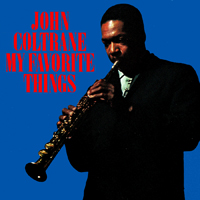Music |
John Coltrane: My Favorite Things
By
Published: Apr 05, 2022
Category:
Jazz
Note from a reader: They used to have what was called The Famous Ballroom in Baltimore, where, for $3, you could go any Sunday afternoon and see some of the greatest jazz musicians of that time. It was BYOB, and the place held probably 600 people, at big tables — it was a great way to spend a Sunday. When Coltrane was there, for the first time since I’d been going, the line outside went around the block. The place was jammed as Trane began, accompanied by Pharaoh Sanders, Alice Coltrane, Rashied Ali, and I can’t remember who else was in the band. By the second set, the ballroom was half empty. This was not music for this audience. Me, I stood up the whole time, transfixed and entranced. I was awakened in a way, that day, and I’ve never been the same since. You might say I saw God.
=====================
We have all heard Julie Andrews sing “My Favorite Things” — “Raindrops on roses and whiskers on kittens/Bright copper kettles and warm woolen mittens/Brown paper packages tied up with strings/These are a few of my favorite things” — so often that only hard-core devotees of “The Sound of Music” can stand it.
But in 1959, the Rodgers and Hammerstein song and the Broadway musical were new.
A year later, when John Coltrane recorded an album featuring the song and named the album after it, most Americans had never heard it.
Why should you care about a four-song CD of some very familiar songs — “My Favorite Things” is almost 14 minutes, “Summertime” is 11, with just enough space on the album for “But Not for Me” and “Every Time We Say Goodbye?”
Because it is revolutionary but accessible. Innovative but gorgeous. Great for close listening, a cool choice for dinner music. A career peak when Coltrane’s career was finally catching fire. [To buy the CD from Amazon, click here. For the MP3 download, click here.]
And because the creator — who would go on to record the incandescent A Love Supreme — knew its worth: “my favorite piece of all those I’ve recorded.” His reason:
“I don’t think I would like to do it over in any way, whereas all the other discs I’ve made could have been improved in some details. This waltz is fantastic: when you play it slowly; it has an element of gospel that’s not at all displeasing; when you play it quickly, it possesses other undeniable qualities. It’s very interesting to discover a terrain that renews itself according to the impulse you give it.”
There’s a way of talking about “My Favorite Things” which will be of interest to musicologists — all two of you. It’s about Coltrane’s abandonment of bebop for the modal approach that Miles Davis put to gorgeous use in Kind of Blue, the best-selling jazz record of all time. What it means: no more noisy, discordant improvisation, no more bleats and honks. Instead, you get melody — and then improvisations on melody. Bottom line: It’s easier listening, thus easier for non-musicologists to enjoy.
The title song, for instance. The cymbals at the start say: important, stately, pay attention. Then Coltrane enters, playing soprano sax with wit and warmth, and, if it’s not too strong, love.
I say this because love was definitely in the air during the three days it took to record “My Favorite Things.” Coltrane was playing with his new quartet, an all-star group featuring McCoy Tyner (piano), Elvin Jones (drums) and Steve Davis (bass). A few years earlier, he had, finally, kicked his heroin addiction and made a profound connection: “I experienced, by the grace of God, a spiritual awakening which was to lead me to a richer, fuller, more productive life. At that time, in gratitude, I humbly asked to be given the means and privilege to make others happy through music. I feel this has been granted through His grace.” He felt light, free, ready to exult. And he does, taking a simple song and turning it into an Eastern dance.
“My Favorite Things” was released as a single. It became a hit. So did the album: 50,000 copies sold during 1961. And Down Beat Magazine’s editors named Coltrane Jazzman of the Year. They weren’t wrong.


